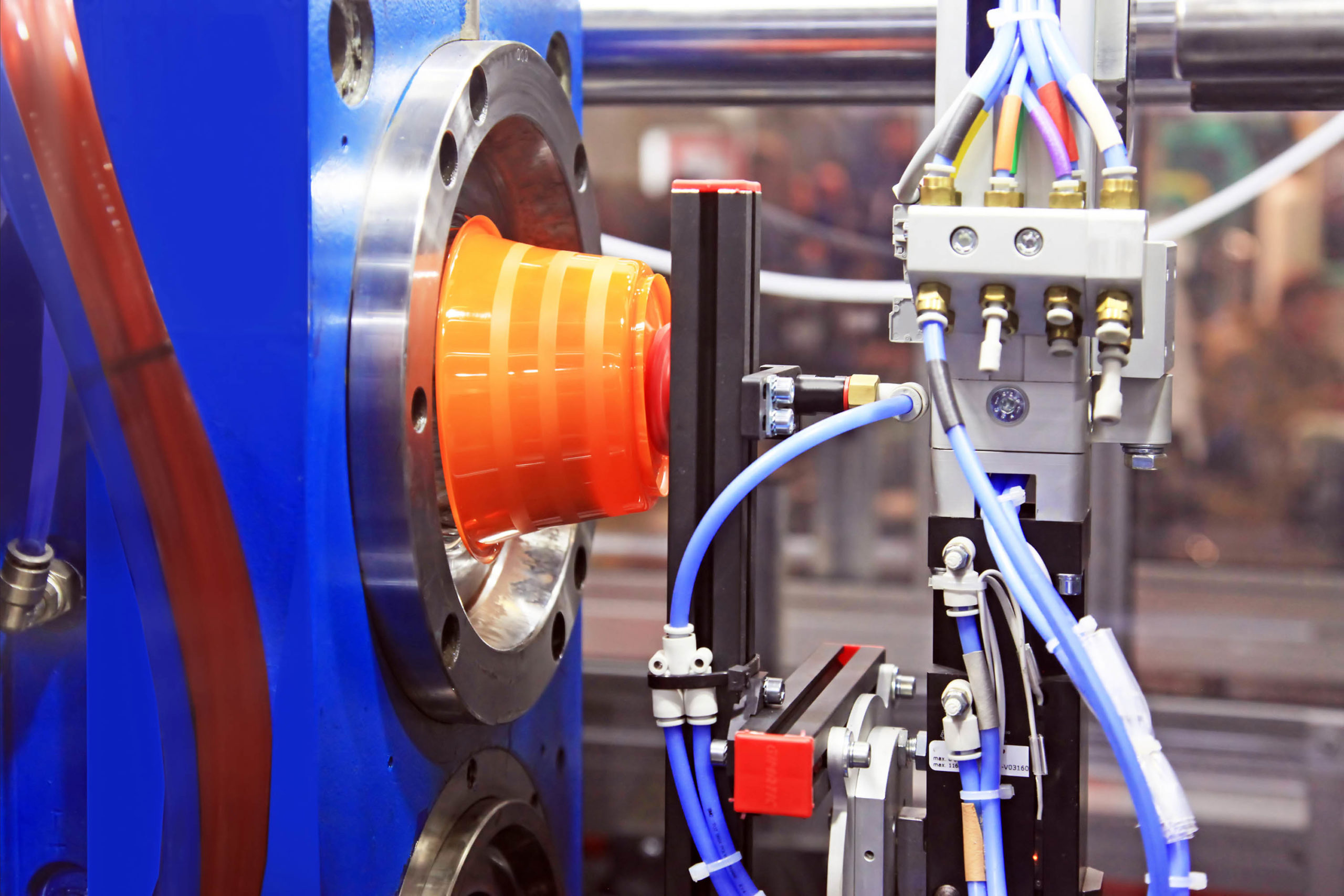According to Statista, installed wind power worldwide reached a cumulative capacity of almost 743 GW (gigawatts) in 2020 and is expected to reach almost 841 GW by 2022. As it remains a competitive source of renewable energy, engineers are looking for ways to enhance the efficiency and reliability of wind farms and the turbines that comprise them. One design aspect under consideration is the seals that are used in these turbines. This week, we will discuss the various benefits of spring-energized seals for wind turbines.
Fluoropolymers for Injection Molding: Challenges and Solutions
Fluoropolymers are used in many different industries and applications, ranging from medical devices to oil and gas. Engineers often assume that just because a part is to be manufactured from a fluoropolymer that it cannot be injection molded, but that is not correct. Fluoropolymers are not just limited to manufacturing processes such as machining, compression molding, or sintering.
What Are Fluoropolymers?
A fluoropolymer, as the name implies, is a fluorocarbon-based polymer with multiple carbon–fluorine bonds. Fluoropolymers are known for certain characteristics such as …
- Very low friction
- Non-stick
- Excellent performance in high temperatures
- High purity and non-toxic
- Aging is minimal
- Easy to sterilize
- Excellent resistance to acids, bases, and solvents
- Also resistant to microbiological and enzyme attack
- Good electrical insulating properties
Commonly Used Fluoropolymers
The most commonly used fluoropolymers include …
- ECTFE (ethylene chlorotrifluoroethylene), trade name Halar
- ETFE (ethylene tetrafluoroethylene), trade names FluonETFE, Neoflon, and Tefzel
- FEP (fluorinated ethylene propylene), trade names Dyneon FEP, Neoflon FEP, and Teflon FEP
- FPM/FKM (fluoroelastomer), trade names Viton, Tecnoflon FKM, DAI-EL, and Fluonox
- PFA (perfluoroalkoxy alkane), trade name Chemfluor, Hostaflon PFA, and Teflon PFA
- PTFE (polytetrafluoroethylene), trade name Teflon
- PVDF (polyvinylidene fluoride), trade names Hyldar, KF, Kynar, and Solef
- PVF (perfluoroalkoxy), trade names Teflon PVF, Fluon PVF, and Dyneon PVF
Only some of these fluoropolymers have the properties that allow them to be injection molded. What makes the difference is whether they are melt processable.
Melt Processable Fluoropolymers
For a fluoropolymer to be injection molded, it must be melt processable. And while some materials like PVF may offer excellent properties, they cannot be injection molded. . However, PFA, FEP, PVDF, ETFE, ECTFE, and PCTFE are melt processable and can be injection molded. PTFE can also be injection molded, but it takes an extremely high level of skill and specialized equipment. In fact, just because a fluoropolymer can be injection molded does not mean there are not major challenges.
Common Issues With Injection Molding Fluoropolymers
Injection molding offers a host of benefits in manufacturing and is a popular choice for a wide variety of components. However, there are certain problems that must be addressed for fluoropolymer injection molding, including high melt temperature, high melt viscosity, high shear sensitivity, and fluorine outgassing.
High Melt Temperature
A very high melt temperature is required to work with fluoropolymers, and the injection molding equipment and molds may reach temperatures up to 800°F. Hot runner systems are also needed, and careful attention goes into the design of runners and gates to encourage even flow of the material. However, the temperatures must remain controlled to avoid degrading the fluoropolymers.
High Melt Viscosity
Another complication lies in the fact that fluoropolymers such as PFA have a high melt viscosity, which is related to how flexible the polymer chains are as well as their degree of entanglement. Polymers that have a high melt viscosity flow very slowly even in their melted form and the melt can actually fracture if it encounters sharp edges or gates and runners that are too small.
High Shear Sensitivity
Another challenging aspect of injection molding a fluoropolymer is their high shear sensitivity. A material that exhibits shear sensitivity changes its viscosity when subject to stress or pressure, which is a problem. The viscosity of the polymer melt will vary significantly as it goes through the various stages of injection molding.
Fluorine Outgassing
Fluorine outgassing occurs when these polymers are melted, presenting another issue because of the corrosive effects of fluorine gas on barrels, screws, nozzles, runner systems, and molds. To make matters more complicated, fluorine gas is also highly toxic.
Solutions for Injection Molding Fluoropolymers
Solutions have been developed to address the challenges involved with fluoropolymer injection molding, starting with thermal management.
Thermal Management
Managing the temperature of the polymer melt as it passes through the various stages in the injection molding is vital to keeping the polymer flowing predictably. It also helps to ensure the integrity of the final part by preventing degradation of the polymer melt. The different zones and points have specific temperatures at which they should be kept and this requires highly precise thermal management.
Gate, Runner, and Mold Design
While any injection molded part requires careful design of the gate, runner, and mold, this is especially important in the context of fluoropolymers. Depending on the fluoropolymer being processed, there are certain key dimensions for gates, hot runner systems, and the mold cavity. There also exist recommendations for the gating systems, such as whether tunnel, sprue, or fan gating should be used. In addition, careful design is needed to prevent issues with melt fracture.
Corrosion Resistant Materials
Barrels, screws, nozzles, runner systems, and molds must be made from materials that are corrosion resistant. The materials for these components have to possess excellent high-temperature material properties including hardness and wear resistance. Ther barrel, screw, and nozzle must be manufactured from special materials.
For example, barrel material options include IDM 260, Xaloy 309, and Wexco B022 often work well. Effective screw materials are usually certain grades of Inconel and Hastelloy as well as Haynes 242 alloy. For the nozzle tip there are Hastelloy grades that provide the needed properties.For the molds, materials such as plated tool steel or nickel alloys possess the needed corrosion resistance, thermal performance, and wear properties.
Venting
Fluorine outgasses can be managed with proper venting, but the materials for the vent must be extremely corrosion resistant. Furthermore, the vents must be kept very clean. In addition to the danger of outgassing, gas trapped within the mold must also be addressed in order to avoid part defects and reduce the maintenance required to keep the molds ready to use.
Conclusion
There are certain fluoropolymers that can be injection molded, but certain issues must be addressed to successfully manufacture parts of the quality and integrity needed. And while there are many companies that are good at injection molding parts, not all of them have the equipment and experience to injection mold fluoropolymers.
Here at Advanced EMC, we have the equipment and skill to successfully manufacture fluoropolymer parts through injection molding. In fact, we offer engineering assistance to help you select the best type and grade of material and configure your parts to make them as manufacturable as possible. Our injection molding machines range from 75 to 500 ton and we have a Class 100,000 clean room if needed. Contact us today for all your fluoropolymer needs.
- « Previous Page
- 1
- …
- 61
- 62
- 63
- 64
- 65
- …
- 190
- Next Page »


